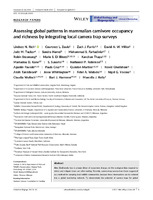Assessing global patterns in mammalian carnivore occupancy and richness by integrating local camera trap surveys
Date
2017-06-23Author
Rich, Lindsey N.
Davis, Courtney L.
Farris, Zach J.
Miller, David A. W.
Tucker, Jody M.
Hamel, Sandra
Farhadinia, Mohammad S.
Steenweg, Robin
Di Bitetti, Mario Santiago
Thapa, Kanchan
Kane, Mamadou D.
Sunarto, S.
Robinson, Nathaniel P.
Paviolo, Agustín Javier
Cruz, María Paula
Martins, Quinton
Gholikhani, Navid
Taktehrani, Ateih
Whittington, Jesse
Widodo, Febri A.
Yoccoz, Nigel G.
Wultsch, Claudia
Harmsen, Bart J.
Kelly, Marcella J.
Metadata
Show full item recordAbstract
Biodiversity loss is a major driver of ecosystem change, yet the ecological data required to detect and mitigate losses are often lacking. Recently, camera trap surveys have been suggested as a method for sampling local wildlife communities, because these observations can be collated into a global monitoring network. To demonstrate the potential of camera traps for globalmonitoring, we assembled data from multiple local camera trap surveys to evaluate the interchange between fine- and broad-scale processes impacting mammalian carnivore communities.Location: Argentina, Belize, Botswana, Canada, Indonesia, Iran, Madagascar, Nepal, Norway, Senegal, South Africa, and the U.S.A.Methods:We gathered camera trap data, totalling>100,000 trap nights, from across five continents. To analyse local and species-specific responses to anthropogenic and environmental variables, we fitted multispecies occurrence models to each study area. To analyse global-level responses, we then fitted a multispecies, multi-area occurrence model.Results:We recorded 4,805 detections of 96 mammalian carnivore species photographed across 1,714 camera stations located in 12 countries. At the global level, our models revealed that carnivore richness and occupancy within study areas was positively associated with prey availability.Occupancy within study areas also tended to increase with greater protection and greater distances to roads. The strength of these relationships, however, differed among countries.Main conclusions:We developed a research framework for leveraging global camera trap data to evaluate patterns of mammalian carnivore occurrence and richness across multiple spatial scales.Our research highlights the importance of intact prey populations and protected areas in conserving carnivore communities. Our research also highlights the potential of camera traps for monitoring wildlife communities and provides a case study for how this can be achieved on a global scale. We encourage greater integration and standardization among camera trap studies worldwide, which would help inform effective conservation planning for wildlife populations bothlocally and globally.
Collections
The following license files are associated with this item:




